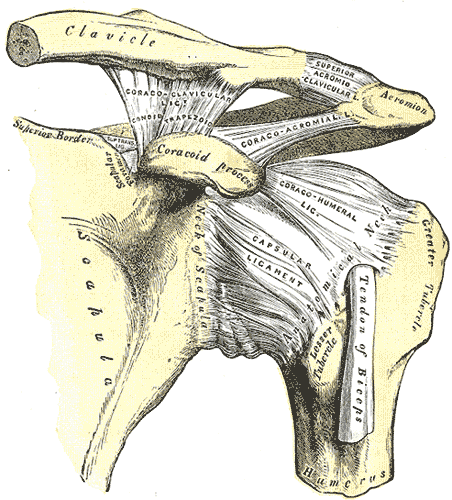◔
Acromioclavicular Joint: Difference between revisions
From WikiMSK
No edit summary |
No edit summary |
||
| (5 intermediate revisions by the same user not shown) | |||
| Line 1: | Line 1: | ||
{{Joint | {{Joint | ||
|image=Shoulder and acromioclavicular joint with ligaments gray.png | |||
|caption=Left [[Glenohumeral Joint|shoulder]] and acromioclavicular joint | |||
|quality=Stub | |quality=Stub | ||
|type=Synovial Joint | |type=Synovial Joint | ||
|secondary-type=Planar Joint | |secondary-type=Planar Joint | ||
|bones=Scapula, Clavicle | |bones=Scapula, Clavicle | ||
|ligaments=Coracoclavicular, coracoacromial, superior acromioclavicular, and inferior acromioclavicular ligaments | |feature=Fibrocartilaginous wedge-shaped disc. | ||
|ligaments=Coracoclavicular, coracoacromial, superior acromioclavicular, and inferior acromioclavicular ligaments. | |||
|muscles=No muscles directly act on this joint. | |muscles=No muscles directly act on this joint. | ||
|innervation=Axillary, suprascapular, and lateral pectoral nerves | |innervation=Axillary, suprascapular, and lateral pectoral nerves | ||
|vasculature=Suprascapular and thoracoacromial arteries | |vasculature=Suprascapular and thoracoacromial arteries | ||
|conditions=[[Acromioclavicular Joint Osteoarthritis]], [[Acromioclavicular Joint Injury]] | |conditions=[[Acromioclavicular Joint Osteoarthritis]], [[Acromioclavicular Joint Injury]] | ||
|volume=2mL | |||
|rom=Upward rotation: 30 degrees, external rotation:8 degrees | |||
}} | }} | ||
The acromioclavicular joint (ACJ) is formed by the junction between the acromion process of the scapula and the distal clavicle. It is a plane synovial joint and forms part of the shoulder girdle (ACJ, [[Glenohumeral Joint|GHJ]], and [[Sternoclavicular Joint|SCJ]]). It can include a fibrocartilaginous disk | |||
==Range of Motion== | |||
There is significant motion at the ACJ during elevation of the humerus.(See [[Shoulder Biomechanics]]).<ref>{{Cite journal|last=Teece|first=Rachael M.|last2=Lunden|first2=Jason B.|last3=Lloyd|first3=Angela S.|last4=Kaiser|first4=Andrew P.|last5=Cieminski|first5=Cort J.|last6=Ludewig|first6=Paula M.|date=2008-04|title=Three-dimensional acromioclavicular joint motions during elevation of the arm|url=https://pubmed.ncbi.nlm.nih.gov/18434666|journal=The Journal of Orthopaedic and Sports Physical Therapy|volume=38|issue=4|pages=181–190|doi=10.2519/jospt.2008.2386|issn=0190-6011|pmc=2759875|pmid=18434666}}</ref> | |||
== References == | |||
[[Category:Shoulder Anatomy]] | |||
[[Category:Joints of the Upper Limb]] | |||
Latest revision as of 17:21, 30 April 2022
This article is a stub.

| |
| Acromioclavicular Joint | |
|---|---|
| Primary Type | Synovial Joint |
| Secondary Type | Planar Joint |
| Bones | Scapula, Clavicle |
| Feature | Fibrocartilaginous wedge-shaped disc. |
| Ligaments | Coracoclavicular, coracoacromial, superior acromioclavicular, and inferior acromioclavicular ligaments. |
| Muscles | No muscles directly act on this joint. |
| Innervation | Axillary, suprascapular, and lateral pectoral nerves |
| Vasculature | Suprascapular and thoracoacromial arteries |
| ROM | Upward rotation: 30 degrees, external rotation:8 degrees |
| Volume | 2mL |
| Conditions | Acromioclavicular Joint Osteoarthritis, Acromioclavicular Joint Injury |
The acromioclavicular joint (ACJ) is formed by the junction between the acromion process of the scapula and the distal clavicle. It is a plane synovial joint and forms part of the shoulder girdle (ACJ, GHJ, and SCJ). It can include a fibrocartilaginous disk
Range of Motion
There is significant motion at the ACJ during elevation of the humerus.(See Shoulder Biomechanics).[1]
References
- ↑ Teece, Rachael M.; Lunden, Jason B.; Lloyd, Angela S.; Kaiser, Andrew P.; Cieminski, Cort J.; Ludewig, Paula M. (2008-04). "Three-dimensional acromioclavicular joint motions during elevation of the arm". The Journal of Orthopaedic and Sports Physical Therapy. 38 (4): 181–190. doi:10.2519/jospt.2008.2386. ISSN 0190-6011. PMC 2759875. PMID 18434666. Check date values in:
|date=(help)

